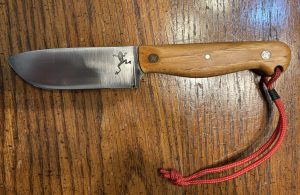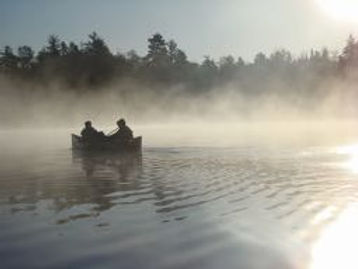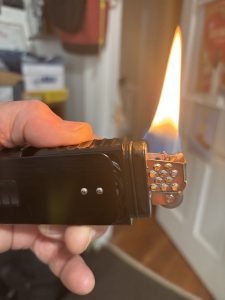
TWENTY TIPS FOR CANOEING THE BOUNDARY WATERS



Much as I love canoeing wild, fast rivers, I can’t escape the lure of the Boundary Waters. And every year, since 1971 (when I moved from Indiana to Minnesota) I’ve made at least two annual trips there.
I’ve observed that two types of people generally paddle the BWCA: (1) Inquisitive souls who are always on the prowl for better gear and methods–they read canoeing books and blogs, attend canoeing and camping seminars and interact with fellow paddlers; and (2): those who have canoed the BW for years and consider themselves experts. They generally do the same route every season, camp in the same spots and use the same inferior equipment. They’ve never read an outdoor skills book or attended a canoeing-camping seminar. They have the earmarks of experts but are rank novices who haven’t grown with the sport. Put them on a wild Canadian river and they’ll be lucky to survive.
Admittedly, expedition procedures which can make or break a dangerous river trip, are overkill for the peaceful waters of the BWCA. Here, you can usually get along fine with minimal gear and knowledge if you know your limits and don’t take chances. But to maximize the “fun”, you’ll need some skills and tricks. Here’s a short list of some of them:
1. All the good firewood on popular campsites has been picked over. You’ll need to hike into the woods, saw off some thick branches from a dead, downed tree, then split them to get at the dry wood inside. For this, you’ll need a saw and an axe. A light hatchet is enough if you use the two-person splitting method I recommend in my books. Yes, the Forest Service does frown on axes in the Boundary Waters because unthinking people often chop green trees with them! (Frankly, more often than not, today’s villain is the saw.) Still, if the firewood is wet from recent rains, and you don’t have a splitting tool, you’ll have smoke not fire! Except for short, go-light trips, experienced canoe campers ALWAYS bring an axe!
2. Use a plastic groundcloth INSIDE your tent, NOT under the floor as recommended by “experts” who haven’t camped in heavy, prolonged rain. Make the groundcloth a foot larger than the tent floor all around so that any water that seeps into your tent will be trapped under the plastic. This is the best wet-weather tip in my wardrobe of skills.
3. If you want to develop good judgment (and have more fun!) don’t blindly take every marked portage. First, check the stream that the portage bypasses. It may be canoeable or lineable. You won’t know if you don’t look. And by looking, you’ll learn what is doable and what is not. Lining canoes along the edge of rapids is a daily routine on difficult rivers. You can learn the basics on the small streams of the BWCA. Naturally, your canoe must be equipped with 15-20 foot ropes (lines) at each end.
4. Bring a nylon tarp for rain. Rig it every night even if the weather looks good. Then, if you awaken to rain, you’ll have a dry place to cook and relax Tip: Attach the leading edge of your tarp to a tight rope strung between two trees. This distributes the wind-stress along the full hem of the tarp rather than just at two opposing corners. It’s also wise to bring one or two collapsible poles so that you can rig your tarp on sites that don’t have “properly spaced” trees. My book, Boundary Waters Canoe Camping, details rigging procedures.
5. A high wind can turn an unsecured canoe into a kite! Pull your canoe well up on shore when you camp; turn it over and tie it to a tree. Canoeing experts who paddle by will respect you for your thoughtfulness.
6. Fire-making will be a lot easier if you bring a stainless-steel Littlbug® stove. These simple, ultralight wood-burning stoves are remarkably efficient, even in rain. They burn brightly, even with damp wood. They accept small twigs and wrist-thick logs and take up almost no space at all when packed. The Littlbug® is legal in the BWCA if you set it right next to the grill or on top of it. An armful of wood will burn brightly for hours. I might add that if you canoe western rivers where fire-pans are required (these are dreadfully bulky and heavy!) a Littlbug® stove, plus a high-sided round baking pan, will save a lot of weight and bulk and meet federal fire-pan requirements.
7. Pack in odd units–three or five packs, not two or four. This way, each person will make two trips over the portage. Trip one: each partner carries a pack, paddle and sundries; trip two: one partner carries a pack and the remaining gear, the other carries the canoe. Note that the canoe is best left for last. Why? Because if you have a canoe overhead and encounter an obstacle you can’t walk around you’ll have to drop the canoe to clear the obstacle. And without the canoe overhead, you might just get lucky and discover a shorter route to the end. Those who routinely paddle off the beaten track ALWAYS carry their canoe last.
8. A capsize is unlikely in the Boundary Waters. But packs have been dunked when loading and unloading canoes. For this reason, it’s smart to use expedition-proven procedures to waterproof your gear (see my book, Canoeing Wild Rivers, 5th Edition). A single plastic pack liner isn’t enough!
9. Bring a “multi-pliers” (I prefer the Leatherman®) and wear it on your hip. It’s useful for moving burning firewood, picking non-burnable trash from your cold fire-site; to lift a pot or pot cover; remove a fishhook; tighten a pesky zipper slider and more.
10. Load your canoe dead-level! The canoeing literature is rich with advice on how to load for various wind conditions–namely, bow down in a head-wind and stern down in a tail wind. Unless the wind is steady and you have a long ways to go, you’ll handicap yourself by any trim other than dead-level.
11. Unless you and your partner are well skilled, don’t quarter into big waves (to increase lift) as advised in most canoeing texts. Running 30 degrees off a wind that is trying to twist you around requires team coordination. Failing that, you will broach to the waves and possibly capsize. Better to head directly into oncoming waves. Quartering is for experienced teams!
12. Don’t fight the canoe in an off-beam wind. Instead, both paddlers should stroke on the down-wind side. If this won’t hold the course, the bow paddler should “paddle hard” while the stern person holds a tight rudder to maintain direction.
13. Bring 150 feet of brightly-colored parachute cord (cut into15-20 foot lengths/individually coiled) and twice as many stakes as your tent and tarp normally need. If a big wind comes up you may need all those stakes and cords to stabilize your camp. Tip: Bring a variety of tent stakes so you’ll have what’s best for different types of ground. I bring 8-inch long tempered aluminum pins for rocky ground and 12-inch long Easton aluminum “arrow-shaft” stakes for everything from gravel to sand. These Easton stakes are expensive, and worth it. The 12-inchers (recommended) are not easy to find. They’re available from Cooke Custom Sewing (cookecustomsewing.com).
14. Bring insulated “cozies” for your pots. Put a “cozy cover” on top of your pot cover to keep heat in while you’re heating water/food. Soon as it boils, stir the food and water then remove the pot from the heat. Place the pot on a square of closed-cell foam and cover the pot with an insulated cozy cover. Fifteen minutes later your meal will fully cooked and not burned! Cozies save fuel and cooking time and they keep food hot long enough for seconds.
15. Bring a set of lightweight wool long underwear, even for trips in the heat of July. When there’s a long, cold rain, nothing feels better against your skin than merino wool. If you’re on a serious budget, polyester and acrylics are an inexpensive way to go.
16. Bring one or two “Luci Lights.” The “Luci Light” is an ultra-light, solar-charged lantern. Its 10 LED lights put out about as much light as a 40 watt lightbulb! Hang it in the sun for a few hours when you camp and it will light up your tent for half the night. Luci lights can be hung, set on the ground or used as flashlights. They compact to an inch thick for easy packing and inflate to lantern size in seconds with a few puffs of air. If a storm confines you to your tent for long periods, you’ll wish you had one!
17. Lighting camp stoves and fires is safer and easier if you have a long-handled “spark lighter”.
18. If you bring a GPS, be sure your maps have UTM coordinates so you can plot GPS positions. Without these coordinates, you’ll have to rely on the tiny screen map which can be confusing. The National Geographic map package (two maps cover the BWCA) has precise UTM coordinates, as do the on-line maps from mytopo.com. You can download mytopo.com maps and print them yourself, or order them (on waterproof Tyvek) direct from the company. Mytopo.com lets you configure your map in the scale, coordinate system and orientation of your choice.
19. You’ll save money and produce better tasting meals if you avoid pre-packaged camping meals and instead dehydrate and vacuum-seal your own foods. I like to keep things simple so I dehydrate just three things: hamburger, canned beans and salsa. If you have hamburger, tomato sauce (I buy tomato powder on line), cheese (fresh sealed cheese easily keeps two weeks), pita bread and/or tortillas, instant rice and mashed potatoes, you can make many tasty meals: chili, spaghetti, beef and bean burritos, cheese quesadillas, hamburger/cheese fortified soups and more. Vacuum-sealed dehydrated foods will keep for a year without refrigeration; longer if you keep them frozen until shortly before your trip. Dried, vacuum-sealed foods are largely odor-free, so few worries about critters. My books, Boundary Waters Canoe Camping, and Basic Illustrated: Cooking, suggests menus. My favorite BWCA meal is steam-fried pita-pizza. Each pizza takes just one minute to make!
20. WEAR YOUR PFD! There’s a saying: “Canoeists always wear their life-jackets; canoers never do! That’s because “canoers” don’t know what they don’t know–like what happens when a lightweight Kevlar canoe capsizes far from shore in a big wind. You can try to catch it, but you won’t! Wearing a PFD even when conditions suggest you don’t need one, separates real paddlers from wanna be’s!
————————-
*My teen book, JUSTIN CODY’S RACE TO SURVIVAL! mixes a fictional wilderness survival tale with practical outdoor tips everyone should know–a first for books of this type. Adults love it too! Now available as an audio book!

